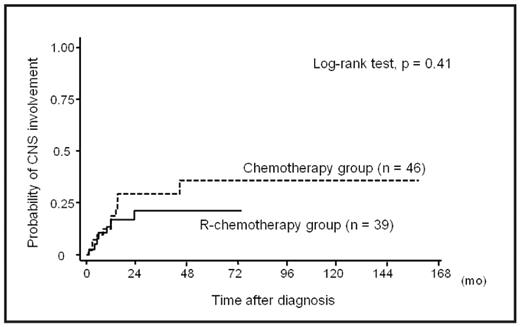Abstract
Central nervous system (CNS) recurrence is a serious and usually fatal complication in the clinical course of aggressive lymphoma. Although our recent report suggested that the improvement of clinical outcomes in intravascular large B-cell lymphoma (IVLBCL) by the application of rituximab, the clinical impact of CNS recurrence in IVLBCL is unknown. To evaluate risks and risk factors associated with development of CNS recurrence in IVLBCL, we retrospectively analyzed 106 patients with IVLBCL receiving chemotherapies with or without rituximab, using our recent cohort (Shimada et al. J Clin Oncol. 2008). Clinical outcomes for our cohort were updated as of December 2007. For this analysis, we excluded 21 of 106 patients (20%) with CNS involvement at diagnosis, which was diagnosed by imaging modalities including computed tomography (CT) and/or magnetic resonance imaging (MRI), and/or cerebrospinal fluid (CSF) analysis. In all, 46 patients (54%) and 39 patients (46%) received chemotherapies without rituximab (chemotherapy) and with rituximab (R-chemotherapy), respectively. With a median follow-up for surviving patients of 39 months (range, 2–158 months), 11 of 46 patients (24%) in the chemotherapy group and 7 of 39 patients (18%) in the R-chemotherapy group developed CNS recurrence after beginning chemotherapy. Median duration between diagnosis and CNS recurrence in the both groups was 9 months (range, 1–44 months). Three patients in the each group displayed CNS progression on the initial series of chemotherapies. Risk of CNS recurrence at 3 years reached 29% in the chemotherapy group and 21% in the R-chemotherapy group, respectively (log-rank test, P = 0.41) (shown as figure). In univariate analysis, use of rituximab combined with initial chemotherapies was not identified as favorable predictive factors. In 12 patients who received autologous stem cell transplantation before CNS recurrence, 1 patient developed CNS relapse by the end of the study. Median survival after CNS recurrence was 6 months (range, 1–58 months), and survival rate at 2 years after CNS recurrence was 14%. This study indicates that CNS recurrence remains a critical problem in the rituximab era. Further studies are required to establish the optimal treatment strategy for CNS prophylaxis in IVLBCL.
Disclosures: No relevant conflicts of interest to declare.
Author notes
Corresponding author


This feature is available to Subscribers Only
Sign In or Create an Account Close Modal